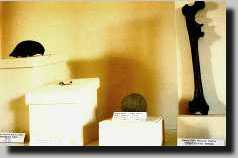|

TRINIL
Fosil on display
in the trinil museum
 |
|
The Trinil Museum can be found
close to the village of Kawu, about 12 km west of Ngawi. Officially
opened only nine years ago, the building is located on the bank
of the Solo River, just 100 metres from where Eugene Dubois carried
out his excavations in 1891. Today, the museum receives a regular
stream of visitors, who come from all over the world to gaze
at the strange assortment of fossils bearing labels such as 'leg
bone of a rhinoceros, circa 500,000 years B.C.'. Aside from a
sizeable collection of old bones and teeth, the museum also displays
replicas of the skull and thigh bone of Java Man, the originals
of which are now kept in the Bandung Museum of Archaeology. Perhaps
the prize exhibit at Trinil is a complete mammoth's tusk measuring
about three metres in length, which is displayed under glass
in the centre of the exhibition room. |
Whether or not one is a fossil fanatic, the museum is well worth
a visit, if only to stand on the spot where our ancestors walked
a million years ago.The man largely responsible for the promotion
and maintenance of the Trinil Museum was Pak Wirodiharjo, a local
resident and farmer. The following is a personal account of the
site's development over the years, translated from the original
Indonesian language.
'After
three years of elementary school I continued my studies for a
further two years until 1932. This was during the Dutch colonial
period. Following Independence in 1945 I became a watchman (hansip)
and was diligent in my work. Then, in 1965, I was promoted to
the position of representative of the Head of the village of
Kawu, a post which I held for two years. After 1967 I lived as
a farmer and became attracted by the historical importance of
Trinil, which was close to Kawu. I noticed the monument erected
there in memory of Eugene Dubois, who had carried out excavations
between the years 1891 and 1893. But the condition of the site
was very sad to see.
|
